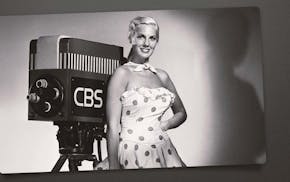A small fallout of warblers appeared in trees near Lutsen, Minn., on the North Shore one day in mid-May. A fallout is a rest and refueling stop for migrants. For birders it's often a chance to see several species in one place.
Several in this case was six, a mini-fallout, but not a complaint in these days of shrinking bird numbers.
I once was surrounded by more than two dozen fallout warblers, maybe three dozen, I was too excited to count. It was a mixed flock one spring day long ago near Bemidji.
I was fresh out of the Army then, using my mom's binoculars because I was yet to be employed. The eyepieces in her bins were out of whack, not focusing in unison, headache glass.
I'd guess she bought them at Woolworth's (for those unfamiliar with the name, it was like a Dollar store only better).
I had done some birding in the Army, bobwhite, vultures and red-tailed hawks easy to see and hear during my time in basic training at Fort Leonard Wood in Missouri.
I later spent 18 months at Fort Devens in Massachusetts, living off-post in the town of Ayer, near a wealth of parks, reserves, preserves and sanctuaries.
I had no binoculars then, so stalked birds, learning to appreciate those that could be identified with eyes or ears only. They tended to be large and distinct, like jays and woodpeckers, gulls and herons. My warbler list was short.
I had a Peterson bird identification book, good for subtleties I could not see in Ayer. The same book was with me in Bemidji. Such books are a blessing and a curse for beginners, as I was then.
I'd pick out a bird with those crummy binoculars, note its markings, then riff through the book looking for a match. I was uncertain. Now the bird had moved. Phooey. Pick another bird. Find another page.
If you didn't need to use the book, progress I had yet to make, a fallout was a lot more fun.
I slowly became active in the birding community here, making friends who helped with the what and where. I learned of the in-state birding tours offered by Duluth's Kim Eckert (now in its 35th year, mbwbirds.com).
I was a frequent participant, following Eckert's pointing finger to new birds in hotspots all over the state.
He also offered weeklong trips to Texas and Arizona (still does, now including the Black Hills and Southern California). I went with him twice to southeastern Arizona and twice to the Rio Grande valley in Texas. I became a baptized birder on those trips.
I also bought decent binoculars, unwilling to pop for airfare, lodging and the tour while using dime-store glass. I up-up-upgraded to Bausch & Lomb 8x42 Elites, now the pair we keep near the feeder window. They were replaced with a pair of Swarovski EL 10x32s, perfect size for my hands, light in weight, beautiful glass.
My wife uses a small pair of Nikons; her Leitz Trinovid 7x35s serve as a spare.
By the way, the first number in binocular size refers to magnification, the second number to the light-gathering ability of the tool. Good binoculars, like Swarovskis, even 32s, seem to add light to shaded areas, enhancing the image.
Lifelong birder Jim Williams can be reached at woodduck38@gmail.com.
It was once a center of Islamic learning. Now Mali's historic city of Djenné mourns lack of visitors
At Memphis BBQ contest, pitmasters sweat through the smoke to be best in pork
Landslide forces closure of iconic Southern California chapel designed by Frank Lloyd Wright's son




